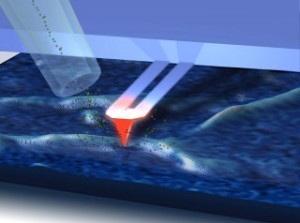Anasys Instruments Corp. has licensed a Department of Energy Oak Ridge National Laboratory technology that allows for simultaneous chemical and physical characterization and could lead to advances in materials and drug development.
 A heated atomic force microscope cantilever probe touches a surface to be analyzed with vapor from surface material that is thermally desorbed. The heat is drawn into the ion source of the mass spectrometer, ionized and then detected and analyzed by a mass spectrometer. Source: ORNL
A heated atomic force microscope cantilever probe touches a surface to be analyzed with vapor from surface material that is thermally desorbed. The heat is drawn into the ion source of the mass spectrometer, ionized and then detected and analyzed by a mass spectrometer. Source: ORNL
The technique, which combines the power of atomic force microscopy and mass spectrometry, fills a void and streamlines analytical processes that are vital to science and industry, said Roshan Shetty, chief executive officer of Anasys Instruments. He also noted that the technology improves the current spatial resolution of ambient methods for mass spectrometry imaging by a factor of more than 100, resulting in imaging resolution as small as 250 nanometers, or 1/400th the thickness of a human hair.
“This capability could have a tremendous impact on a broad field of applications in materials and life sciences ranging from single-cell imaging to polymer composites,” Shetty said.
The license is the culmination of several years of research by a team led by Gary Van Berkel of ORNL’s Chemical Sciences Division. The team’s research has focused on mass spectrometry-based imaging pushing toward nanoscale imaging at ambient conditions using atomic force microscopy.
“No other group has these capabilities, and this research distinction made Oak Ridge National Laboratory the ideal partner,” Shetty said.
Van Berkel noted that the patented technique opens a world of opportunities.
“This new capability allows us to map, for instance, the degradation of organic compound-based solar cells at the chemical level, the metabolites produced from living bacterial colonies and the distribution of dosed pharmaceuticals and their metabolites in tissues and cells,” Van Berkel said.
Measurements of physical and chemical processes using these new tools could provide the knowledge required to boost research in areas ranging from energy materials to drug discovery, according to Van Berkel.
Anasys Instruments, located in Santa Barbara, is a leader in the field of nanoscale imaging and analytics and expects to have a commercial product available sometime in 2015. More information about Anasys is available at http://www.anasysinstruments.com.
Others members of the invention team are Stephen Jesse of ORNL’s Center for Nanophase Materials Sciences and Olga Ovchinnikova, also a member of the Chemical Sciences Division. The research was funded by DOE’s Office of Science.
The Center for Nanophase Materials Sciences is one of the five DOE Nanoscale Science Research Centers, premier national user facilities for interdisciplinary research at the nanoscale supported by the Office of Science. Together the NSRCs comprise a suite of complementary facilities that provide researchers with state-of-the-art capabilities to fabricate, process, characterize and model nanoscale materials, and constitute the largest infrastructure investment of the National Nanotechnology Initiative. The NSRCs are located at DOE’s Argonne, Brookhaven, Lawrence Berkeley, Oak Ridge, Sandia and Los Alamos national laboratories. For more information about the NSRCs, please visit http://science.energy.gov/bes/suf/user-facilities/nanoscale-science-research-centers/.
UT-Battelle manages ORNL for the Department of Energy’s Office of Science. DOE’s Office of Science is the single largest supporter of basic research in the physical sciences in the United States, and is working to address some of the most pressing challenges of the time. For more information, please visit science.energy.gov.